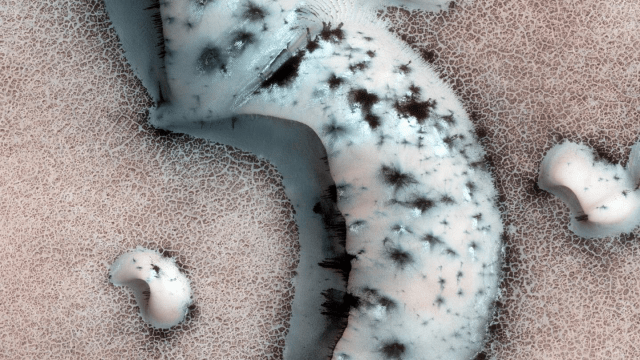Mars’ surface, as far as we can tell, is not habitable to humans — it’s far too cold. But eventually, humanity would like to put an outpost on the planet. That will require warming things up a bit, but how?
Scientists now propose using an insulating material called silica aerogel to make parts of the Martian surface friendlier to photosynthetic life, aka plants. It’s by no means suggestive of a planet-wide terraforming project, but perhaps an aerogel blanket could more easily melt the water on the Martian ice caps to make a small section of the planet habitable to longer-term human or plant visitors.
“The nice part is that the other ways you can think of to terraform a planet are so far out there,” Laura Kerber, research scientist at NASA’s Jet Propulsion Laboratory, told Gizmodo. Far from radical science, silica aerogels are a small, scalable technology that already exists.
Humans have already demonstrated that they’re quite good at heating up planets, thanks to the greenhouse effect, which is when a material (carbon dioxide, for example) absorbs sunlight and then reradiates it, keeping the area below warmer than it would be otherwise. But it’s unfeasible to warm an entire planet this way — past results have already shown that there isn’t enough carbon dioxide on Mars to terraform it with today’s technology. So the researchers instead focused on how they might be able to heat small parts of the surface with as little effort as possible, say, for a research outpost.
Silica aerogel would induce the greenhouse effect. It’s a material that’s mostly air by volume, trapped by a network of silicon dioxide. Thanks to its properties, a few centimetres thick layer can transmit the visible light that a plant would use for photosynthesis, block harmful ultraviolet radiation, and warm the area beneath it.
The team built an experimental setup where they shined an approximately Martian-level of light onto the gel, and measured a difference of more than 50 degrees Celsius between the top and bottom. Such a material might therefore be useful to raise the ground temperature in the region around the Martian poles. Kerber proposed producing tiles of the material that could be assembled into a greenhouse-like structure.
One researcher who not involved with the study thought it was a “clever” and “potentially interesting” idea. Bruce Jakosky, professor at the University of Colorado, Boulder, told Gizmodo that it’s not “terraforming” by any means, as other news outlets have already claimed.
Instead, researchers suggest warming a region enough to melt the ice. The team say in their paper, published in Nature Astronomy, that there remain other important constraints for life that such a greenhouse won’t overcome, like the proper atmospheric pressure. Additionally, Kerber pointed out that the silica aerogel is quite brittle, and would need to be doped with another material like a polymer.
But before we even think about transforming some of the Martian surface to make it habitable to humanity, there are a ton of other things to consider. The mere act of establishing a base on Mars brings up a conversation of who should go and why, and Mars might have its own extant life today, which the presence of Earthlings (human, plant, or microbial) would complicate the search for. Kerber herself pointed out that terraforming the planet would destroy the “pristine” environment scientists want to research.
Terraforming Mars is probably bad idea. “It’s dangerous,” Jakosky said. “It suggests we don’t have to worry about maintaining an environment here on Earth. That’s not a good concept.” But perhaps building a smaller structure would allow researchers to perform experiments without all of the potentially bad results.
Ultimately, this is proof-of-principle research, and a human settlement on Mars remains an idea of the distant, speculative future. But for now, the researchers hope to test their material in hostile environments on Earth in Antarctica or Chile. And unlike the speculative technology required to transform a whole planet, building a greenhouse from a material that already exists doesn’t seem quite as difficult.
